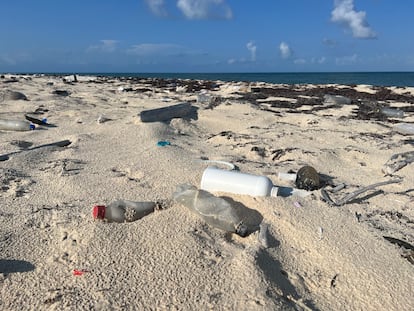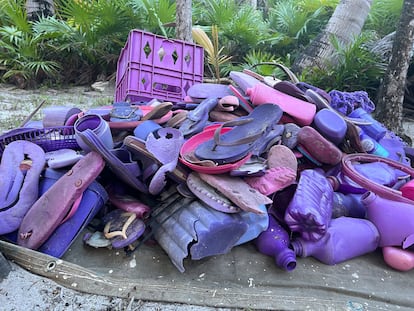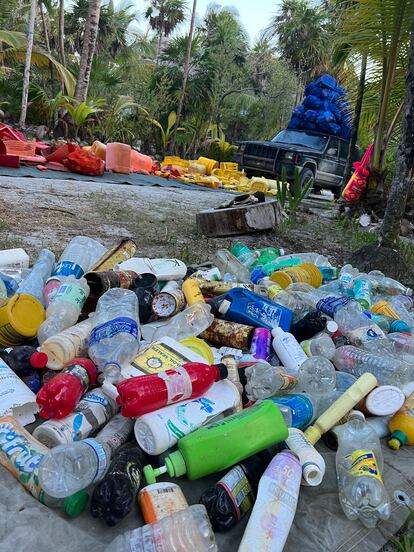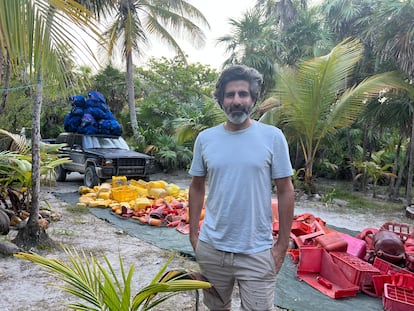Tulum, a paradise full of trash that seeks to reinvent itself (original) (raw)

The pristine beaches of Tulum (Mexico) are spoiled by the trash left behind by tourists.Agustina Grasso
Thirty years ago, it was considered a haven in the Riviera Maya for those looking for a vacation less about all-inclusive packages and more about yoga and backpacking. But the last bastion of hope in Mexico seems to have lost the battle against the big hotel chains. According to official data from the National Institute of Statistics and Geography (Inegi), 20 years ago, the population of Tulum was under 7,000. Today there are already close to 47,000 residents in a city without sufficient infrastructure for that level of growth.
And what about the beaches? They have been suffering the same way as the rest of the Caribbean, as Bad Bunny rightly says in his song El Apagón sobre Puerto Rico: access to the sand remains in the hands of hotel chains and local communities end up losing their sea, a phenomenon known by some specialists as tourist extractivism. And the more tourism, the more business, the more consumption, the more waste.
Tourist trash
Two million tourists come to Tulum a year, and 120,570 tons of waste are generated annually, according to the Secretary of Ecology and Environment (SEMA). Local legislation establishes that in hotel areas, all large and medium-sized generators of garbage must hire a company to manages their waste.
Paula Romalde Cohen, an advisor to Real State Sustentable and a resident of La Veleta in Tulum, a neighborhood that stands out for its boutique hotels, says that “60% of the garbage in La Veleta is generated by condominiums.” Their consortium, Meet Point, created a waste separation and composting system a few months ago, and if guests do not comply, they are charged a fee: “It is key that we became aware and started the changes from within our own communities,” she says.

Tourist garbage collected on the beaches of Tulum.Agustina Grasso
Lack of public policies
In Mexico, by law, waste management depends on local municipalities. And in Tulum, according to the citizens themselves, the municipal recycling system leaves a lot to be desired. Although there is an ordinance banning the use of bags and straws, it is very common to see vacant lots, roads and roadsides littered with this kind of trash.
Against this backdrop, residents are demanding more and better policies. Faced with a vacuum, a citizen initiative called Tulum Sostenible has emerged and is conducting a Puntos Limpios program: a series of 12 recycling centers with containers where people can bring paper, food packages, aluminum, metal, PET plastic and HDPE plastic. “The module with its separator cells is located in a public area and is managed by a group of guardians made up of local residents. Material can be deposited there 24 hours a day”, says Karla Acevedo.
The Clean Points coordinator explains that this system is designed to provide infrastructure that the municipality does not have. “We generated a program with various points: education, infrastructure and participation. Everything is run by citizens and it is important to highlight this, because it is an example of what we can achieve with commitment. There are recycling modules a few blocks away from everyone, so there are no excuses for people to throw everything away without separating.”
According to the General Directorate of Sustainable Urban Territorial Development and the Directorate of Environmental Sustainability of the Municipality of Tulum, there are a few city-run programs such as Recycling, where recyclable waste is collected on the last Friday of each month at six collection points in downtown Tulum. There is also the La Ruta Program, focused on recyclables from small businesses, and the Adopt Life program, through which recyclables are exchanged for native plants.
However, for Karla Acevedo, “the lack of infrastructure prevents the application of waste separation regulations even when there is a legal framework and outreach in this regard.” According to this expert, having all the necessary resources is necessary for a successful implementation.
Within the private sector, a company named Tulum Circula is dedicated to environmental management through actions for the recovery and proper management of waste and beach cleaning.

Plastic containers recovered from the coast of Tulum.Agustina Grasso
A sea of plastic
In Tulum, after passing the hotel zone, one enters the Sian Ka’an biosphere reserve, an area of 600,000 hectares protected by UNESCO. However, not even the reserves are safe from contamination. A three-and-a-half-hour drive from its entrance there is a beach where nobody lives and where there are no hotels or tourism. This pristine area is nevertheless flooded by a sea of plastic that stretches to the horizon. The sand is full of shoes, bottles, lamps and more bottles. They are objects that the sea washes to shore.
Environmentalists demand a solution to the problem, as other countries do where nets are placed that capture plastic from the sea before it reaches the coast and affects marine ecosystems. So far, there has been no answer.
A few minutes from there, the landscape changes. There are garbage piles arranged by color, like a work of art. Red, blue, green, yellow. A kind of giant model made from waste. It is a traveling garbage museum, known as the Washedupproject.
Alejandro Durán, a Mexican environmental artist and photographer, is the director of the ephemeral museum. He himself seeks to raise awareness about the garbage problem through art: he documented waste from 58 countries on six continents that reaches the shores of Sian Ka'an.
“This is a butter wrapper from Haiti. This bottle is from Jamaica. Here it says Dominican. This is the international garbage route. There are no borders, there are no limits to garbage,” he explains as he rummages through all the containers that he has separated, and which can be seen in his “museum” until the end of the first week of June.

Alejandro Durán poses next to piles of garbage collected from the beaches of Tulum.Agustina Grasso
There is the trash that is visible, and the trash that is invisible. A green group called Eco Caribe notes that waste often ends up in cenotes, the underground aquifers that abound in the Yucatán peninsula. A study by the United Nations University Institute for Water, Environment and Health (UNU-INWEH) found contaminants in the groundwater of the Riviera Maya, ranging from residues from the pharmaceutical and cosmetic industries to pesticides and other chemicals.
Tulum is just one example of how humanity devastates everything in its path. In addition to the white sand and the palm trees, there is something that is no longer missing from the photos of visitors to this spot: the waste. The garbage is everywhere. As Durán notes, “there are no borders, nor limits for garbage.”
Sign up for our weekly newsletter to get more English-language news coverage from EL PAÍS USA Edition